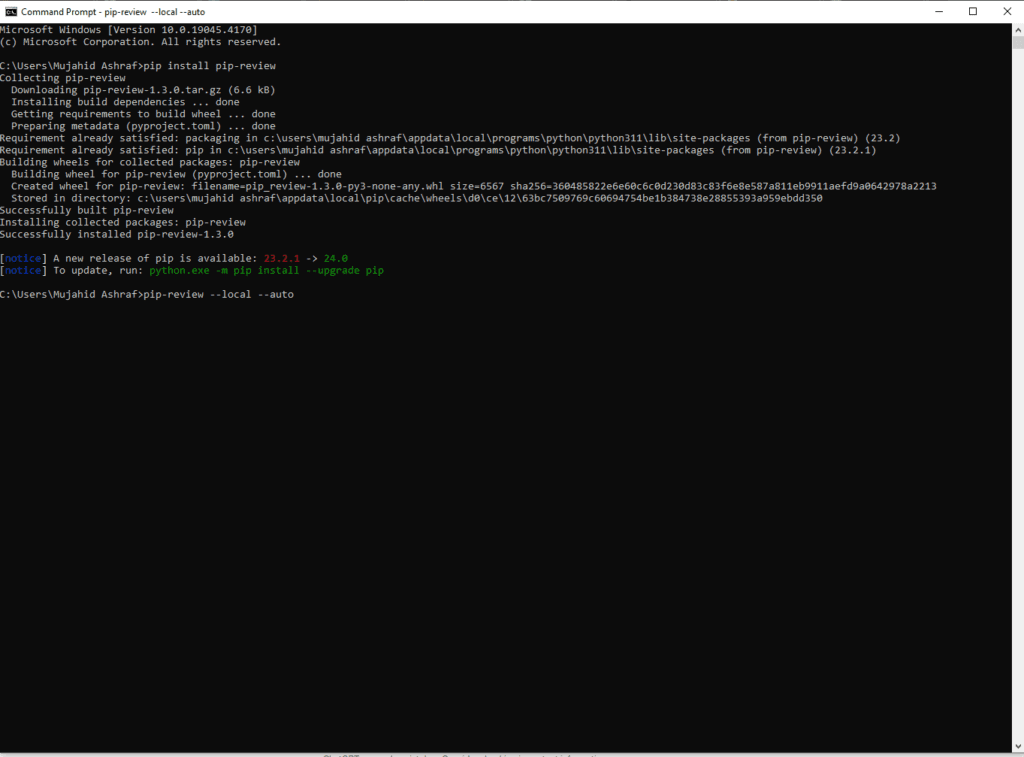- Introduction
- Understanding the Importance of Package Upgrades
- Checking Current Package Versions
- Package Upgrades with pip Command (Pip Version < 22.3)
- Upgrading All Packages with pip freeze Command (Older Versions of Pip)
- Using Pip-Review for Package Upgrades
- Python Code for Package Upgrades
- Conclusion
Introduction
In the world of Python development, keeping your project’s dependencies up to date is crucial for maintaining security, stability, and performance. Fortunately, Pip, the package installer for Python, provides various methods to upgrade all Python packages seamlessly. In this detailed guide, we’ll explore multiple approaches to upgrading Python packages using Pip, catering to developers of all skill levels.
Understanding the Importance of Package Upgrades
Security patches
One of the most critical reasons for Package Upgrades is to patch security vulnerabilities. As software evolves, new security threats emerge, and developers release updates to address these vulnerabilities. Failing to Package Upgrades leaves your application vulnerable to exploitation, potentially leading to data breaches, system compromises, or other security incidents.
Bug fixes
Updates often include bug fixes that address issues discovered in previous versions of the software. These bugs could range from minor inconveniences to critical errors that cause the application to malfunction or crash. By staying up-to-date with Package Upgrades, you ensure that your application operates smoothly and efficiently.
Performance improvements
Developers continually refine and optimize their code to enhance performance. Updating packages can bring performance improvements, such as faster execution times, reduced memory usage, or optimized algorithms. These enhancements can have a significant impact on the overall performance and responsiveness of your application.
Compatibility
New versions of packages may introduce compatibility with the latest versions of Python or other dependencies. By updating regularly, you ensure that your application remains compatible with the broader ecosystem of libraries and frameworks it relies on, reducing the risk of compatibility issues or dependency conflicts.
Access to new features
Updates often introduce new features, functionalities, or enhancements that can improve your workflow or expand the capabilities of your application. Staying current with Package Upgrades allows you to take advantage of these new features and incorporate them into your projects.
Community support
By using the latest versions of packages, you remain aligned with the broader developer community. This can be beneficial for troubleshooting issues, accessing support resources, or collaborating with other developers who are also using up-to-date software versions.
Checking Current Package Versions
When managing Python projects, it’s crucial to have a clear understanding of which packages are installed and their respective versions. The pip list command provides a convenient way to view this information.
To utilize pip list
- Open Command Prompt or Terminal: Navigate to the directory where your Python project is located.
- Enter the Command: Type
pip listand press Enter. - View Installed Packages and Versions: Once the command executes, you’ll see a list of installed packages along with their corresponding versions. This list will include both the name of the package and its version number.
pip list
Example Output
Package Version
-------------------------
numpy 1.21.3
pandas 1.3.4
matplotlib 3.4.3
requests 2.26.0
Interpreting the Output
Each row represents a package installed in your Python environment. The first column displays the name of the package, while the second column shows its version number.
Package Upgrades with pip Command (Pip Version < 22.3)
Upgrading packages with older versions of Pip
pip list --outdated --format=freeze | grep -v '^\-e' | cut -d = -f 1 | xargs -n1 pip install -U
Upgrading All Packages with pip freeze Command (Older Versions of Pip)
Upgrading packages with legacy versions of Pip
pip freeze --local | grep -v '^\-e' | cut -d = -f 1 | xargs -n1 pip install -U
Using Pip-Review for Package Upgrades
Installing and utilizing pip-review for streamlined package upgrades
pip install pip-review
pip-review --local --auto

Python Code for Package Upgrades
Upgrading packages programmatically using Python
For Pip < 10.0.1
import pip
from subprocess import call
packages = [dist.project_name for dist in pip.get_installed_distributions()]
call("pip install --upgrade " + ' '.join(packages), shell=True)
For Pip >= 10.0.1
import pkg_resources
from subprocess import call
packages = [dist.project_name for dist in pkg_resources.working_set]
call("pip install --upgrade " + ' '.join(packages), shell=True)
Conclusion
Keeping Python packages up to date is essential for maintaining the health and efficiency of your projects. With the diverse methods outlined in this guide, you can confidently upgrade all Python packages using Pip, regardless of your Pip version or familiarity with Python. By embracing proactive package management practices, you’ll ensure your projects remain secure, stable, and primed for success in the ever-evolving Python ecosystem.





